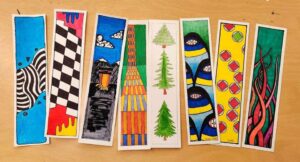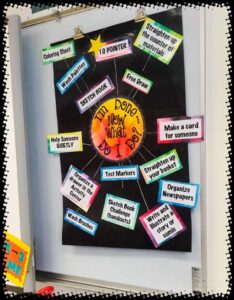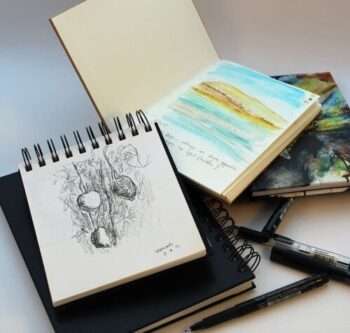There is no worse phrase in the art room than “I’m done. Now what?” It’s inevitable that some students will finish before others. While we can close the gap to some degree, we can’t avoid the reality of early finishers. If you teach middle school or intro high school classes you know it’s imperative for some classes that you keep them busy less your class falls into total anarchy. So, here are some ways to deal with those legitimate early finishers.
- Visual Journals/sketchbooks/sketchbook prompts
Sketchbooks can be really useful in the art room. From planning artwork, taking notes, practicing sketching, and trying out new techniques there is no shortage of ways to utilize them. Having a sketchbook also means students always have a creative activity. You can read more about sketchbooks here. Some teachers make sketchbook drawings mandatory and others leave them optional. You can have students paste a list of sketchbook prompts to the insider cover of their sketchbooks so they are ready with options when they have free time. - Mini projects
Zentangles. flextangles, origami, magnet tiles, beads, snowflakes designs, grid handouts, paper weaving, etch-a-sketch, mini rainbow scratchboard, clay for stop motion app
-
Use your learning management systems
Art teacher Jordan Brun writes, “I have a weekly discussion on canvas that encourages an open forum where they evaluate a work, find an element or principle of design, or disseminate a technique based on the media of the course.” Brun provided an example. Have a student look at a piece, like this one, and try to figure out how an artist did it. - Artists challenges
This month, ask students to take part in the Inktober challenge. And there are more challenges out there. Check out this list. - Cleaning tasks.
Now, some students will not stoop so low but many will enthusiastically tackle cleaning or organizational tasks, god bless them! Other students will conveniently find other productive things to do, and that can be fine too. - Extra steps in the project
Art teacher Megan Paige provides ways students can take on extra steps or challenges in their projects.

- Long-term side projects
Have some long-term side projects that are self-paced for early finishers. This can be an opportunity to teach the artistic behavior of having more than one project going at once. It can also be a great way to find out what motivates a student. If they are interested in animation maybe they learn how to create a storyboard or make a flip book.
- Giant Coloring Posters
Some students really enjoy them and it really makes the art room look like a fun place. You can find examples, here and here. Or make your own! - Artist Trading cards
- Book Marks
This year, art teacher Will West has been giving bonus points to students for making “bookmarks” that demonstrate techniques or materials for the project they just finished. “It’s like a miniature skills recap,” West explains. “It also gives me something to do with the half-zillion 2″x8″ strips of paper I have after cutting down the full-size sheets.” Coordinate with your school or community library where they could be given away.

- The “I’m done” file or binder
Alisha Marchewka shared, “I have a box with different handouts (Art word searches, coloring pages, grid drawing practice, and blank paper).

Along the same lines art teacher KayDee Reynolds has a binder of activities. Her binder “contains coloring pages and also a variety of step-by-step how to draw pages for them to learn from.”
Early finisher binder ideas can be found here. - The 20% project
What is the 20% percent project you ask? 20 percent time, sometimes called “Genius Hour,” seeks to marry achievement and engagement by carving out space in the schedule for students to ask and answer their own questions. Read more here.
Art teacher Abigail Arellano writes, “I’ve looked into the 20% project. I had the kids put together a list of things they would like to do art related and if they finish early they work on the 20% project. They get one grade at the end of the semester but it’s something they chose. I.e. Create an Etsy shop, work on a painting, learn to sew (small patterns they can sew by hand like stuffed animals), and create a YouTube video teaching how to do something.” - Make an online Portfolio
Have students create online portfolios where they document their assignments from beginning to end. Early finishers can expand and write intro blurbs about themselves and artist statements about their work. - Art-related books, stories, and movies
I find it inspirational to read about artists or see a film about artists. Obviously, pick age-appropriate choices and always prescreen materials.
Some that I like include Chuck Close: Face Book, Chasing Vermeer, Before They Were Artists: Famous Illustrators As Kids, I, Juan de Pareja, The Second Mrs. Gioconda, Girl with a Pearl Earring, - Pull and draw
Jill Willis writes,” I do “Pull and draw” where they draw a small prop out of a bag and have to draw it spending time and not rushing, etc.” Some ideas of items- pinecones, shells, sunglasses, geode, reflective objects like a Christmas ornament or spoon, origami crane, ribbon, feather, etc. - Challenge wall
UK art teacher Kay Elizabeth Burgess shares, “I have a challenge wall. It lists a series of different activities that can be applied to whatever the learning objective is of the lesson. My students know that once they’ve done they then need to challenge themselves and independently do this.

- Art games
A few popular ones:
WatchamaDrawit
Pictureka
Roll-a-miro
HUES and CUES
Mythical Creatures Drawing Game & Animal Art Ideas
Starving Artists Game
*see more in this post - The paint chip challenge
Jenn Lynch Postman developed what she calls “The paint chip Challenge.” She explains, “If you’re finishing a painting project and have the paint out you can have them do a paint chip challenge. Using primaries, black and white, they have to mix the paint to match the paint chip. I give nominal extra credit points for each one they get and have classes compete against one another. The idea came from Art of Education and my students love it.” - How to draw books
How-to books are great skill builders and confidence builders!
How to Draw Noir Comics: The Art and Technique of Visual Storytelling
How To Draw Comics The Marvel Way
Fashion Illustration Art: How to Draw Fun & Fabulous Figures, Trends, and Styles
- Famous painting puzzles
Van Gogh Puzzle Starry Night
The Kiss by Gustav Klimt Puzzle
The Scream by Edvard Munch - Ongoing collaborative projects
We have an extensive list of ideas here. - Art history
Khan academy has great art history videos. One art teacher has students choose one Khan academy art history video, watch it, and write a response. - Art history parodies
You can find examples and some good content on the topic here. - Creations inspired by Pinterest
One art teacher creates a Pinterest board with random creative ideas like fantasy art, architecture, holiday drawings, cartoons, flowers, cars, surrealism sketches, Tim Burton sketches, tattoo art, and mainly more creative artwork to get them thinking outside of the box. - Community Projects
Sometimes I get requests from teachers or administrators and a happy match to be made by pairing a project up with an early finisher. There are other “do good” projects like the Memory Project and Empty Bowls out there. Or train a student or two in how to change out your bulletin boards. - Bonus! YouTube tutorials
Examples:
Paint Splatter Drawing
How To Draw A Metallic Bow With Colored Pencil: Art Lesson And Tutorial
Fun Stuff- Let’s Draw Cake!
Related Posts
Narrowing the divide: The art room’s early finishers & laggards




